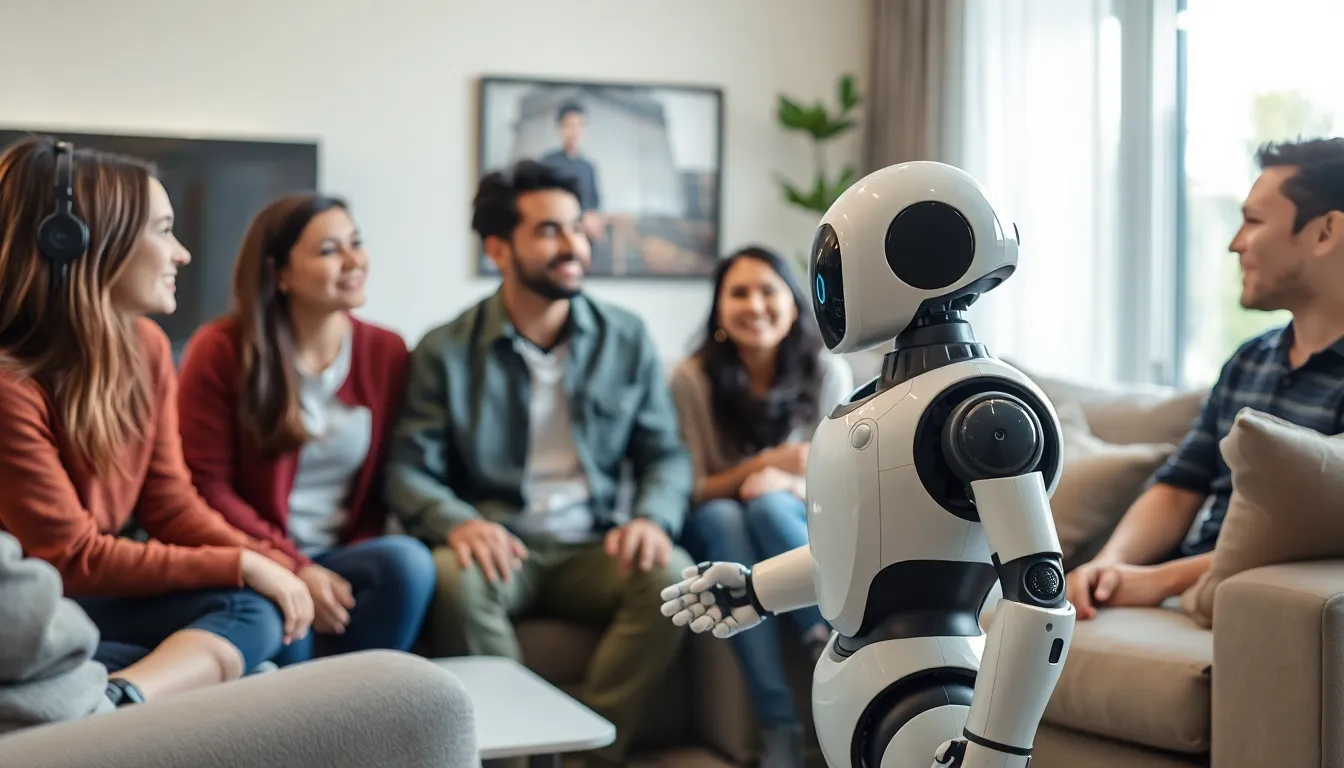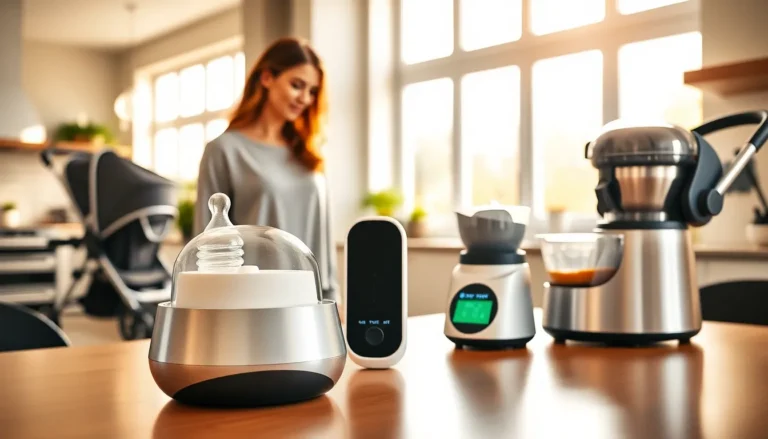In a world where even your toaster can connect to Wi-Fi, smart robot assistants are the next big thing. Imagine a sidekick that not only remembers your schedule but also tells you when to water your plants—because let’s face it, they’re probably thirsty. These little marvels of technology are designed to make life easier, whether it’s managing your to-do list or providing a daily dose of entertainment with a side of sass.
Gone are the days of clunky gadgets and confusing interfaces. Today’s smart robot assistants are sleek, intuitive, and ready to tackle your daily chaos. They might not bring you coffee just yet, but they’ll remind you when it’s time to brew that perfect cup. With their growing capabilities, these assistants are not just a luxury; they’re becoming essential for anyone looking to streamline their life while having a little fun along the way.
Table of Contents
ToggleOverview of Smart Robot Assistants
Smart robot assistants offer efficiency and convenience, playing a vital role in daily life and task management. These devices combine advanced technology with user-friendly designs to enhance productivity and personal enjoyment.
Definition and Purpose
Smart robot assistants refer to AI-driven devices that automate tasks, manage schedules, and provide personalized assistance. Their main purpose centers on simplifying life’s demands, like sending reminders for watering plants or managing to-do lists. These assistants can also entertain users with music, news, or games, making them versatile companions. By integrating voice recognition and machine learning, these robots understand and adapt to individual preferences, ensuring tailored interactions that address specific needs.
Evolution of Technology
The evolution of smart robot assistants is marked by significant technological advancements. Initially, basic devices offered limited functionality, focusing on simple commands and tasks. Today’s models leverage artificial intelligence and natural language processing to communicate naturally with users. Improved hardware allows for sleek designs, making these robots more appealing. Integration with smart home systems enhances their usability, enabling seamless control over various devices. This combination of innovations highlights the shift from static gadgets to dynamic, interactive assistants that continue to evolve and adapt to user preferences.
Features of Smart Robot Assistants
Smart robot assistants encompass advanced technologies that significantly enhance user experience. Their capabilities make daily activities easier and more enjoyable.
Voice Recognition and Natural Language Processing
Voice recognition serves as a key feature, allowing users to communicate effortlessly. Commands spoken aloud are captured accurately, enabling seamless interaction. Users benefit from natural language processing, which interprets and understands speech nuances. This technology helps smart assistants comprehend context and intent, creating a more fluid conversation. Responses become more meaningful, enhancing user satisfaction. Adopting these features, many smart robots adapt to different accents and dialects, broadening their usability. Individual preferences are factored in, providing more personalized and relevant answers.
Machine Learning and Adaptability
Machine learning empowers smart robot assistants, allowing them to evolve over time. Patterns are identified through user interactions, fostering greater efficiency. Predictive capabilities emerge, as assistants learn routines and preferences. Adaptability to changing user needs becomes a standout characteristic. They can suggest new tasks or reminders based on past behaviors. By collecting and analyzing data, these robots improve their recommendations, enhancing user engagement. Continuous updates ensure that smart assistants stay relevant and effective in a rapidly changing technological landscape.
Applications of Smart Robot Assistants
Smart robot assistants integrate seamlessly into various aspects of life, enhancing effectiveness and convenience. Their capabilities extend across numerous sectors, notably in home automation and healthcare support.
Home Automation
Smart robot assistants dominate home automation, managing household tasks efficiently. Devices like smart speakers control lighting, temperature, and security systems with voice commands. Automation schedules daily routines, freeing up time for users. For example, an assistant might turn off lights when you leave home or play music at specific times. They also facilitate easy integration with other smart devices, creating a cohesive home ecosystem that simplifies daily living.
Healthcare Support
Healthcare support represents another vital application of smart robot assistants. These devices remind individuals to take medications at specific times, ensuring adherence to treatment plans. Sensors also track health metrics, providing valuable data to users and healthcare providers alike. For instance, some smart assistants can monitor heart rate and activity levels. They can even assist elderly users by detecting falls and alerting emergency contacts immediately. Such capabilities demonstrate their significance in promoting health and safety, particularly for patients requiring consistent monitoring.
Advantages of Smart Robot Assistants
Smart robot assistants bring numerous benefits, significantly enhancing daily life and work efficiency.
Enhanced Productivity
Smart robot assistants streamline tasks, allowing users to focus on more important activities. Task automation eliminates the need for manual scheduling and reminders. Many users report higher efficiency due to these features, leading to fewer missed appointments and deadlines. These assistants can sort emails, manage calendars, and prioritize to-do lists based on user preferences. Voice commands enhance accessibility, enabling hands-free management of tasks. By adapting to individual workflows, smart assistants optimize efficiency across various responsibilities.
Improved Quality of Life
Quality of life sees considerable improvement with the use of smart robot assistants. These devices provide companionship and support, contributing positively to emotional well-being. Daily reminders for medications or essential tasks create a sense of structure for users. Adaptability ensures that the assistant evolves with personal preferences, fostering a more customized experience. Additionally, assistance with household tasks reduces stress, creating a more manageable living environment. The ability to control various home systems with voice commands enhances convenience, making everyday life smoother and more enjoyable.
Challenges and Limitations
Smart robot assistants face various challenges and limitations, which impact their effectiveness and user trust.
Privacy and Security Concerns
Privacy and security concerns arise prominently when using smart robot assistants. Data collection practices, such as voice recordings and personal information storage, create risks for user confidentiality. Users often worry about unauthorized access to sensitive data, leading to potential breaches. Companies must implement robust encryption methods to safeguard user information. Transparency in data usage policies enhances user confidence, allowing individuals to understand how their information is managed. Instances of data leaks further highlight the necessity for stringent security protocols, as these incidents can damage reputations and user trust. Trust in smart technology hinges on manufacturers prioritizing user privacy, ensuring that devices adhere to ethical data handling practices.
Technology Dependence
Technology dependence emerges as a significant challenge associated with smart robot assistants. Overreliance on these devices can diminish self-sufficiency, as users may become accustomed to automated task management. Individuals might find themselves less prepared to perform essential tasks without assistance. Moreover, frequent dependency fosters a lack of critical thinking and problem-solving skills in certain contexts. If users encounter malfunctions or connectivity issues, they may struggle to manage daily responsibilities effectively. Balancing the convenience offered by smart assistants with the need for personal initiative becomes essential. Encouraging mindful usage promotes a healthier relationship with technology, ensuring that users retain control over their daily activities.
Conclusion
Smart robot assistants are transforming how individuals manage their daily lives. With their ability to streamline tasks and provide personalized support, these devices have become indispensable companions. They enhance productivity and well-being while offering entertainment and companionship.
As technology continues to advance, the capabilities of these assistants will only improve, making them even more integral to modern living. However, it’s crucial to approach their use mindfully, balancing convenience with personal initiative. By doing so, users can enjoy the benefits of smart robot assistants while maintaining control over their daily responsibilities.






